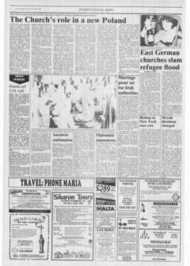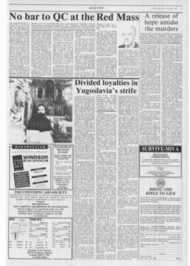Page 5, 29th September 1989
Page 5

Report an error
Noticed an error on this page?If you've noticed an error in this article please click here to report it.
Tags
Share
Related articles
Inside
A Brutal And Illegal Coup
Can Tito's Successors Hold Yugoslavia Together?
Relations With Tito
Gorbachev In Church
Divided loyalties in Yugoslavia's strife
Chris Cviic, eastern Europe writer on the Economist since 1969, considers the place of the churches in post-Tito Yugoslavia in our continuing series on glasnost and religion
COMMUNIST-ruled but independent Yugoslavia, out of the Soviet bloc since 1948, did not have to wait for the appearance of Mikhael Gorbachev in Moscow to introduce more glasnost into its public life. Already under President Tito, the successful partisan guerrilla leader in the second World War and Yugoslavia's ruler after 1945, it had come to enjoy growing freedom of expression.
But as long as Tito was alive there were very clear limits under the ruling party's (official name: League of Communists of Yugoslavia) watchful eye to political and economic change. The so-called "verbal crimes" the singing of a song considered by the authorities to be nationalist or the telling of a political joke could lead to several years in prison.
It was only after Tito's death in 1980 that it became possible to challenge the bases of the regime, particularly the second World War Partisan "foundation myth" built around Tito. Nearly a decade later, the results of what has been an explosion of openness look decidedly mixed. The impassioned debates of the post-Tito years have allowed truths, hitherto suppressed, to come out into the open. But equally there has been political manipulation on a large scale, resulting in the re-opening of old wounds and the creation of new ones.
Yugoslavia's problem is that, unlike Poland and Hungary, it is not a nationally homogenous state but, like the Soviet Union, a multinational federation composed of peoples of different backgrounds and religions who do not, by and large, get on. It is enough to recall that Yugoslavia sits on top of one of the great historical and cultural divides: the line separating the Roman Empire's eastern from its western part, drawn in AD395 by Emperor Theodosius, runs right across today's Yugoslavia from north to south. Yugoslavia's Roman Catholics (Croats and Slovenes) are to the west of that line; its Orthodox (Macedonians, Montenegrins and Serbs) are to the east of it; most of its Moslems, the result of five centuries of Ottoman rule, are athwart it.
The new post-Tito openness has, for example, allowed Medjugorje, with all its undoubted beneficial spiritual effects (whatever the verdict on the nature of the process taking place there). But also the already bitter national and religious conflicts have been aggravated in many places by propoganda campaigns like, for example, that waged by Slobodan Milosevic, the aggressive populist boss of Serbia, Yugoslavia's largest federal republic where the bulk of the country's Orthodox live.
The Serbian Orthodox Church has offered enthusiastic and politically important backing to Mr Milosevic's campaign to regain control over Kosovo, once a province of Serbia's medieval state, but now with a 90 per cent ethnic Albanian majority. That campaign has now been successfully completed with the reincorporation of Kosovo, which became autonomous under Tito, into Serbia in March of this year after a bitter political struggle.
The Serbian Orthodox Church's support is, in some ways, even more important to Mr Milosevic in his present campaign aimed at mobilising the Serbs in Bosnia (32 per cent of the local population) and Croatia (11.6 per cent) as part of his bid to gain supreme power in Yugoslavia.
The Orthodox Church's rewards from the Milosovic regime have included the green light for the building in the middle of Belgrade, Yugoslavia's (and Serbia's) capital, of St Sava's church, the largest religious edifice in south-eastern Europe. As a result of what many Serbs see as the Church's patriotic Serbian stand it has dramatically increased its popularity among the Serbs, even in areas, like .Montenegro, where religious life had virtually died out. People, many of them young, are flocking to religious services. Orthodox church leaders are forever appearing on television and in newspapers, prompting a comment from a well-known Serbian academic that not even the pre-war royalist regime had wooed the Church quite so openly.
The strongly nationalist, xenophobic attitude displayed by a number of leading Serbian churchmen, particularly those who belong to the so-called Athos School of Greece, has caused a deep upset and anger not only among the Albanians, most of whom are (Sunni) Moslems but also among the predominantly Catholic Croats and Slovenes in the west, as well as the Moslems (Slav not Albanian) in Bosnia. Allegations in the Belgrade press of a supposed collusion between the Vatican and Stalin's Comintern (disbanded in 1943) against the Serbs, aimed at dismembering them, were first treated with amusement, but now increasingly with dismay in nonSerbian parts of Yugoslavia.
There is a widespread and not unjustified suspicion in Croatia that the present Belgrade campaign against the "quick" assimiliation of the Serbian minority in Croatia is part of the "Kosovo scenario": first try to paint a picture of persecuted brethren at the hands of "genocidal" oppressors, then demand action to protect them, and then act as Mr Milosevic did in Kosovo. The recent nationalist incidents staged by Serbs in a part of Croatia where the Serbs live, on the occasion of the 600th anniversary of the famous battle of Kosovo in June 1389, when the Turks beat the Serbs, were seen very much in that light in Croatia and Slovenia.
Under severe provocation the reaction from the Catholic Church in Croatia has been restrained. Cardinal Franjo Kitharic, Archbishop of Zagreb, Croatia's capital, has protested against branding Croats as a "genocidal nation" and making the Roman Catholic Church in Croatia and the Vatican coresponsible for the persecution of the Croatian Serbs under the murderous Pavelic regime in Croatia during the German and Italian occupation from 1941 to 1945. But there is a reluctance to answer in kind. Especially in view of the possible effect a vigorous Croatian reaction might have, on the Serbian minority of Croatia, still traumatised by their sufferings under Pavelic.
Ironically, though not unexpectedly, the anti-Catholic campaign from Belgrade has brought about a rapprochement between the Catholic Church in Croatia and the local communist authorities. The Croatian communist leadership sees that campaign, correctly, as also an indirect attack on itself. Hence much better coverage of church affairs in Croatia, interviews with the cardinal and other bishops, increasingly favourable treatment suddenly of Cardinal Stepinac, sentenced by the communists in 1946 to 16 years for alleged wartime collaboration at a rigged trial. Quite clearly the regime would like to secure, in these uncertain times, the backing of the Catholic constituency in Croatia, but without giving too many concessions and without forming an open alliance with the Church, such as that between the Milosevic regime in Serbia and the Orthodox Church. Unlike in Serbia, there has not been in Croatia a sudden rush into the churches, but there is a steady growth of lay groups like the charismatics, the cursillos and the neo-catechumenes and others. They are not yet officially allowed to exist.
In Slovenia, Yugoslavia's most liberal republic, the conditions are becoming steadily more normal. The ruling Slovene party are fighting the Milosevic camp and Catholics are part of a broad Slovene national concensus in favour of market reform and political pluralism. Nevertheless, the public concern expressed by the Catholic bishops in Slovenia, together with those in Croatia earlier this year at the time of the crackdown in Kosovo, for the Albanian miners on a hunger-strike, has provoked a furious reaction in Serbia. So has the fact that the Church in Slovenia has allowed Albanian Catholics working there to hold prayer sessions for peace in Kosovo.
There is also an officially registered Christian Democrat "alternative movement", under the umbrella of the Socialist Alliance. In Croatia too Catholics are members of both the main alternative groupings the Croatian Social-Liberal Alliance, and the Croatian Democratic Alliance, both formed this year.
In Bosnia, the Belgrade campaign has led to a rapprochement between the majority Moslem and the Croat Catholics who together account for two-thirds of the republic's population.
Will the Pope visit Yugoslavia? It is hard to imagine such a papal visit under the present circumstances, though an official invitation was issued not long after Tito's death. One of the reasons perhaps the main reason is the opposition of the Serbs, thought the Orthodox Church is not officially opposed.
There is a special problem: the Pope's likely insistence on a meeting with the Macedonian Orthodox Church which split off from the Serbian Orthodox Church in 1967 and has remained unrecognised by it and other Orthodox churches. The only Christian church there, the Macedonians have contact with is the Catholic Church more fuel for dark Serbian suspicions of the Vatican's "hidden agenda". In these circumstances it is difficult to talk of ecumenism in Yugoslavia.
One of the main tasks of the Christians there is at least to keep the lines of contact open for the time when nationalist passions have abated and dialogue becomes possible again.
blog comments powered by Disqus











